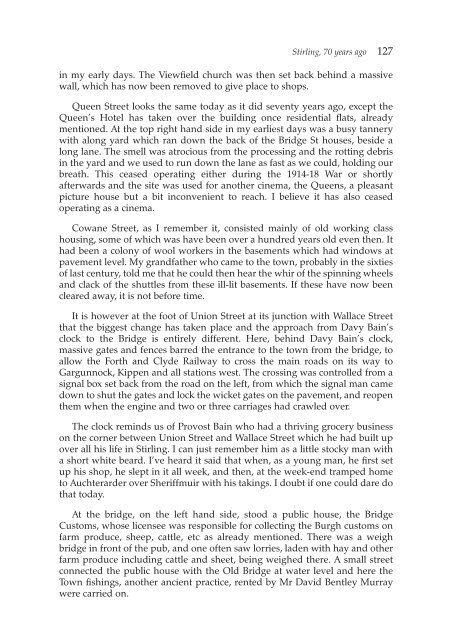the Forth Naturalist Historian - Forth Naturalist and Historian ...
the Forth Naturalist Historian - Forth Naturalist and Historian ...
the Forth Naturalist Historian - Forth Naturalist and Historian ...
Create successful ePaper yourself
Turn your PDF publications into a flip-book with our unique Google optimized e-Paper software.
Stirling, 70 years ago 127<br />
in my early days. The Viewfield church was <strong>the</strong>n set back behind a massive<br />
wall, which has now been removed to give place to shops.<br />
Queen Street looks <strong>the</strong> same today as it did seventy years ago, except <strong>the</strong><br />
Queen’s Hotel has taken over <strong>the</strong> building once residential flats, already<br />
mentioned. At <strong>the</strong> top right h<strong>and</strong> side in my earliest days was a busy tannery<br />
with along yard which ran down <strong>the</strong> back of <strong>the</strong> Bridge St houses, beside a<br />
long lane. The smell was atrocious from <strong>the</strong> processing <strong>and</strong> <strong>the</strong> rotting debris<br />
in <strong>the</strong> yard <strong>and</strong> we used to run down <strong>the</strong> lane as fast as we could, holding our<br />
breath. This ceased operating ei<strong>the</strong>r during <strong>the</strong> 1914-18 War or shortly<br />
afterwards <strong>and</strong> <strong>the</strong> site was used for ano<strong>the</strong>r cinema, <strong>the</strong> Queens, a pleasant<br />
picture house but a bit inconvenient to reach. I believe it has also ceased<br />
operating as a cinema.<br />
Cowane Street, as I remember it, consisted mainly of old working class<br />
housing, some of which was have been over a hundred years old even <strong>the</strong>n. It<br />
had been a colony of wool workers in <strong>the</strong> basements which had windows at<br />
pavement level. My gr<strong>and</strong>fa<strong>the</strong>r who came to <strong>the</strong> town, probably in <strong>the</strong> sixties<br />
of last century, told me that he could <strong>the</strong>n hear <strong>the</strong> whir of <strong>the</strong> spinning wheels<br />
<strong>and</strong> clack of <strong>the</strong> shuttles from <strong>the</strong>se ill-lit basements. If <strong>the</strong>se have now been<br />
cleared away, it is not before time.<br />
It is however at <strong>the</strong> foot of Union Street at its junction with Wallace Street<br />
that <strong>the</strong> biggest change has taken place <strong>and</strong> <strong>the</strong> approach from Davy Bain’s<br />
clock to <strong>the</strong> Bridge is entirely different. Here, behind Davy Bain’s clock,<br />
massive gates <strong>and</strong> fences barred <strong>the</strong> entrance to <strong>the</strong> town from <strong>the</strong> bridge, to<br />
allow <strong>the</strong> <strong>Forth</strong> <strong>and</strong> Clyde Railway to cross <strong>the</strong> main roads on its way to<br />
Gargunnock, Kippen <strong>and</strong> all stations west. The crossing was controlled from a<br />
signal box set back from <strong>the</strong> road on <strong>the</strong> left, from which <strong>the</strong> signal man came<br />
down to shut <strong>the</strong> gates <strong>and</strong> lock <strong>the</strong> wicket gates on <strong>the</strong> pavement, <strong>and</strong> reopen<br />
<strong>the</strong>m when <strong>the</strong> engine <strong>and</strong> two or three carriages had crawled over.<br />
The clock reminds us of Provost Bain who had a thriving grocery business<br />
on <strong>the</strong> corner between Union Street <strong>and</strong> Wallace Street which he had built up<br />
over all his life in Stirling. I can just remember him as a little stocky man with<br />
a short white beard. I’ve heard it said that when, as a young man, he first set<br />
up his shop, he slept in it all week, <strong>and</strong> <strong>the</strong>n, at <strong>the</strong> week-end tramped home<br />
to Auchterarder over Sheriffmuir with his takings. I doubt if one could dare do<br />
that today.<br />
At <strong>the</strong> bridge, on <strong>the</strong> left h<strong>and</strong> side, stood a public house, <strong>the</strong> Bridge<br />
Customs, whose licensee was responsible for collecting <strong>the</strong> Burgh customs on<br />
farm produce, sheep, cattle, etc as already mentioned. There was a weigh<br />
bridge in front of <strong>the</strong> pub, <strong>and</strong> one often saw lorries, laden with hay <strong>and</strong> o<strong>the</strong>r<br />
farm produce including cattle <strong>and</strong> sheet, being weighed <strong>the</strong>re. A small street<br />
connected <strong>the</strong> public house with <strong>the</strong> Old Bridge at water level <strong>and</strong> here <strong>the</strong><br />
Town fishings, ano<strong>the</strong>r ancient practice, rented by Mr David Bentley Murray<br />
were carried on.



